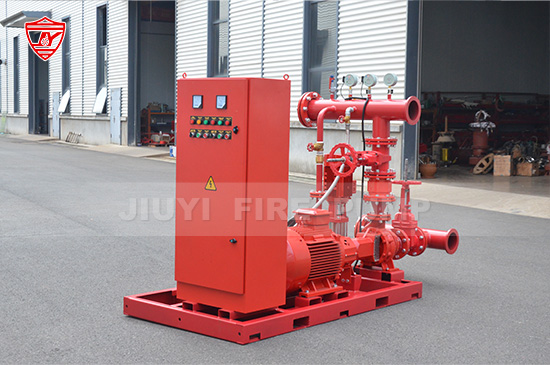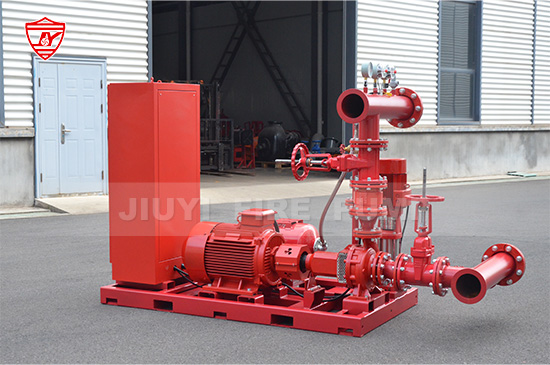Fire pumps are the heart of any fire protection system. They ensure adequate water pressure and flow during emergencies, supporting sprinklers and hydrants when municipal pressure isn’t enough. However, for a fire pump to function reliably, the surrounding environment—particularly the fire pump room—must be properly designed and ventilated.
Ventilation in a fire pump room is more than just about comfort. It’s a critical safety and performance requirement defined by standards like NFPA 20: Standard for the Installation of Stationary Pumps for Fire Protection. Inadequate ventilation can lead to overheating of engines, premature equipment failure, and even system shutdowns during a fire emergency.
This article explains the fire pump room ventilation requirements, including design guidelines, temperature limits, airflow needs, and best practices for both electric motor–driven and diesel engine–driven fire pumps.

The performance and longevity of fire pumps depend heavily on the room environment. Proper ventilation ensures that:
Engines and motors operate within safe temperature limits.
Combustion air is adequately supplied to diesel engines.
Heat from running equipment is expelled, maintaining stable ambient conditions.
Personnel safety is ensured during inspection and maintenance.
Without proper ventilation, overheating may cause:
Reduced efficiency or power loss.
Damage to insulation and bearings.
Risk of automatic shutdown (especially for diesel engines).
Fire pump failure during critical operations.
Simply put, good ventilation equals reliable fire protection.
According to NFPA 20 (2022 Edition), several key requirements govern the design of fire pump rooms and their ventilation systems. While exact specifications depend on the pump type and site conditions, the main principles include:
The maximum temperature in a fire pump room shall not exceed 120°F (49°C) when the equipment is operating.
The minimum temperature shall not be lower than 40°F (4°C) to prevent freezing of water in the system.
Maintaining these temperatures is crucial for ensuring equipment reliability and immediate start-up during an emergency.
Diesel-driven fire pumps require two distinct airflow provisions:
Combustion air – air needed for the engine to burn fuel efficiently.
Ventilation air – air required to remove heat generated during operation.
NFPA 20 requires that ventilation openings or louvers be designed to supply both combustion and cooling air. The air intake must come from an uncontaminated outdoor source, and the exhaust must be properly ducted to the exterior.
A mechanical ventilation fan may be required when natural airflow isn’t sufficient.
Electric fire pumps produce less heat compared to diesel engines but still require proper air circulation to prevent electrical overheating. NFPA 20 mandates that fire pump rooms with electric drives must also be ventilated to maintain room temperature below 120°F (49°C) during full load operation.
In many installations, natural ventilation through louvers or vents is enough. However, in enclosed or underground spaces, mechanical ventilation is recommended.
The design of ventilation openings must ensure effective airflow through the entire room. Key considerations include:
Locate air inlets low and outlets high to promote natural convection.
Size openings adequately to handle both combustion and cooling air requirements.
Provide protective screens to prevent debris or vermin intrusion.
Ensure fire dampers are avoided in pump rooms (as they could restrict airflow during a fire).
For diesel engines, the engine manufacturer typically provides specific airflow requirements (measured in cubic feet per minute, or CFM). These figures must be used in ventilation design calculations.
For diesel engine fire pumps, exhaust gases must be discharged directly outdoors, away from air intakes or nearby structures. Exhaust piping must be:
Constructed of corrosion-resistant, heat-tolerant materials.
Properly insulated to avoid heat transfer to nearby surfaces.
Supported and routed to minimize back pressure, ensuring engine efficiency.
When natural ventilation cannot achieve temperature control, a mechanical exhaust fan system is required. It should:
Operate automatically when the fire pump starts.
Have a non-combustible duct system.
Be powered from a reliable emergency source (so it operates during power failures).
Fans and motors used in the ventilation system should also be rated for continuous duty and capable of withstanding high ambient temperatures.
Designing a compliant ventilation system requires coordination between mechanical, electrical, and fire protection engineers. Below are key factors to consider during design and installation:
The fire pump room should be located at ground level or below-grade, easily accessible for maintenance but separated from other building utilities. The room’s ventilation path should be as direct as possible, minimizing duct lengths and obstructions.
Accurate airflow calculation is essential. For diesel engines, determine:
Combustion air requirement (from engine data sheet).
Cooling air requirement (based on room heat load).
Exhaust flow rate (for exhaust duct sizing).
For electric motors, calculate the total heat rejection from the motor, controller, and pump bearings to size ventilation openings or fans accordingly.
Diesel fire pump rooms can be noisy. When designing ventilation openings, consider noise attenuation using acoustic louvers or mufflers—while maintaining free airflow. Ducts and fans should be isolated to reduce vibration.
Ventilation ducts and openings that penetrate fire-rated walls should be treated carefully. While fire dampers are not permitted, fire-resistant construction materials and noncombustible grilles are mandatory.
Ventilation fans, louvers, and automatic dampers must be powered by a reliable emergency power source, ensuring they remain functional during fire events or electrical outages.
Even experienced contractors sometimes overlook ventilation details. Common issues include:
Undersized louvers, restricting airflow.
Poor exhaust routing, causing recirculation of hot air.
Fan power tied to the main building supply, making it inoperative during power failure.
No coordination with diesel engine manufacturer airflow data.
Neglecting maintenance access for filters, fans, and louvers.
Each of these mistakes can lead to overheating and operational failure during an emergency. Proper design review and commissioning testing are essential before system handover.
Ventilation systems require regular inspection and maintenance to remain effective. Recommended practices include:
Monthly check of air inlets, outlets, and exhaust ducts for blockage or corrosion.
Quarterly testing of mechanical fans for start-up operation with the fire pump.
Annual temperature measurement during full pump operation.
Cleaning or replacement of filters and screens as needed.
Proper documentation of maintenance ensures compliance with NFPA 25 (Inspection, Testing, and Maintenance of Water-Based Fire Protection Systems) and supports insurance audits.
Design openings with at least 1 square foot of area per 1,000 BTU/hr of heat to be removed (as a general rule of thumb).
Use automatic start fans linked to the fire pump controller.
Always locate air inlets near the coolest side of the building and exhausts on the opposite side.
Avoid recirculating hot exhaust into the inlet.
Consider redundant fans in critical facilities for reliability.
These best practices go beyond compliance—they ensure long-term performance and safety of the entire fire protection system.

Proper ventilation in the fire pump room is not just a design detail—it’s a life-safety requirement. It ensures that fire pumps, especially diesel-driven units, operate efficiently even under extreme conditions.
By following NFPA 20 ventilation requirements, verifying manufacturer recommendations, and implementing robust design and maintenance practices, building owners and engineers can achieve both code compliance and reliable system performance.
A well-ventilated fire pump room ultimately guarantees that, when a fire occurs, the fire pump delivers water without failure—protecting property, people, and lives.